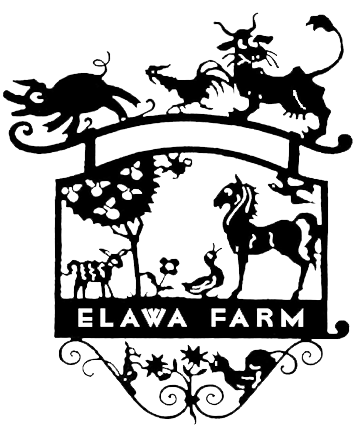
A Brief History
Our History
Elawa Farm was built in 1917 in Lake Forest, Illinois for A. Watson and Elsa Armour.
A. Watson Armour was a member of the family who owned Armour & Company, the largest meat-packing company in the world at the turn of the 20th century.
Our Name
Historically, the farm group built for the Armour family was known as Elawa Farm, a composite of Elsa and A. Watson Armour and subsequently as LeWa Farm, named for Leila and Wallace Carroll, who purchased the property in 1954.
Our Architecture
The Armour family hired renowned architect Alfred Hopkins to bring to life their agrarian vision for the new property. Hopkins worked in concert with Chicago architect David Adler, who designed the residence and outbuildings.
Our Garden
In 1918, the Armours engaged landscape architect Ralph Rodney Root to design a plan for their grounds. Root was known for his formal approach, in contrast to the period’s prevailing trend toward prairie style, which made him a perfect fit to work alongside Elawa’s classical buildings.
Our Restoration
Elawa Farm Foundation was formed in 2002 to raise support for the historic restoration of the property. A proposal was also submitted by a local group of residents to restore the garden back into production. An organic public garden was developed and maintained by these local volunteers and garden enthusiasts, until garden staff were later hired.
The Land
Elawa Farm sits on the ancestral homelands of the Council of Three Fires: the Ojibwe, Odawa, and Potawatomi. This land was also a prominent place of trade for the Sauk, Meskwaki, Miami, Menominee, Ho-Chunk, and Kickapoo peoples.
Elawa Farm is in Middlefork Savanna, home to the highest quality tallgrass savanna in the nation. When the glaciers receded thousands of years ago, they left behind dense clay, sand, and gravel, creating a flat, marsh-like landscape with a mixture of prairies, sedge meadows, and oak woodlands.
With the 1833 Treaty of Chicago, the Potawatomi people were forcibly removed from the area and pushed west of the Mississippi River to new reservations in the Kansas Territory.
In 1838, Scottish immigrant William Steele and his four sons acquired 320 acres of property, including this site. The site became the homestead of James and Ellen Steele, who farmed the land. The Steeles passed the farm down to their daughter, Margaret and her husband Henry Vickerman, and then to their grandson, Robert Vickerman, and his wife Ada. In 1917, the Armours purchased 128 acres of this property from the Vickerman family. The Armours developed the farm buildings that are located at the site today and operated a “hobby farm,” until sold to the Carroll family in 1954. The Carrolls operated the last family farm in the community until it was sold to City of Lake Forest in 1998.
Today, adjacent to Elawa Farm is the ecologically significant Middlefork Savanna, managed by the Lake County Forest Preserve District, and the Middlefork Farm Nature Preserve, stewarded by Lake Forest Open Lands Association.
Today at Elawa Farm
Today, our mission is to steward a historic farm that enriches greater Lake County as a center for experiential learning to broaden access to education, nutritious food, and our local food system.
Through a public-private partnership, Elawa Farm Foundation and the City of Lake Forest work together to steward this historic campus. The City of Lake Forest owns the property and maintains the historic buildings.
Elawa Farm Foundation provides community programming and educational interpretation of the campus and manages the farm grounds, market, kitchen, and educational initiatives.








